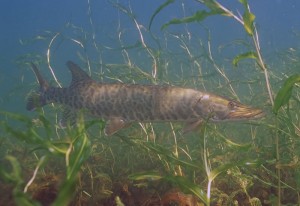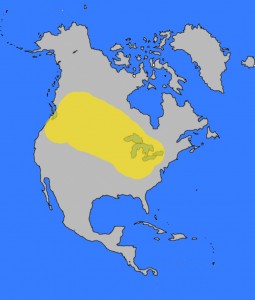Muskie Fishing Facts
Muskie are a beautiful fish that are very light in color compared to the Northern Pike. Northerns are rather dark with lighter spots where Muskies are mostly Lighter with sometimes darker spots. The body shapes however are very similar and they come from the same family of fishes. Like the Pike they are many sharp teeth so be very careful while handling them. They are considered to be the largest member of the Pike Family. They feed similar to their darker cousins in regards to the way that they ambush their prey. They will wait in fairly shallow water covered by weeds or other cover waiting for their next meal to swim by. They will them shoot out like a dark swallowing their meals head first. Muskie are also known to follow prey similar to a Saltwater Barracuda inspecting and analyzing it before they take a bite from it.
They can grow as large as 60 lbs and 5 feet long. Muskie take a very long time to grow however and can easily fall victim to over fishing practices. The possession of Muskie is strictly regulated to help preserve the fishes population. Their fertilized eggs also do not cling like that of the Northern Pike so they are more easily consumed by predators. They generally spawn in waters that are between 48-59 degrees. It is highly encouraged to perform “Catch and Release” when catching a Muskie to help preserve their presence.
A Muskies long snakelike body offers an excellent fight once on the line. Pound for Pound they offer one of the best fishing experiences an angler can expect while freshwater fishing. Their long bodies also allows them to locate nearby prey using their lateral line system. Keep this is mind while choosing your bait, you want a bait that will make a lot of movement in the water.
How to catch Muskie
Their are a few methods used to catch Muskies. Casting is one such method. You can cast spinner bait, plugs and what are referred to as “Musky Bucks” which are larger spinners. Cast in locations where there is Milfoil, Lilly pads or other areas where Musky can hide out and wait in order to ambush their prey. They do not always sit motionless either as some have been seen cruising the bottom, seeking out an easy meal. Mostly the larger muskies behave like this because as they have less to worry about in regards to other larger predators in the nearby waters.
Trolling for Muskie is also another popular method using the same types of lures mentioned above. You can find lures that are supposedly made just for Muskie fishing, but they are essentially the same types of lures for Bass or Pike just on the larger side.
Live lining smaller fish is also a popular method. Shiners, Suckers, Pan-fish even smaller Pike can be used to catch Muskie. Like the Pike they are known to be cannibalistic so be careful if you catch a smaller Muskie as a Larger one may decide to bite it in half. Reports of this have happens and often surprise unsuspecting anglers.
It is highly recommended that you use either a wire leader or a fluorocarbon leader due to the fact that Muskies will bite through 20lb+ fishing line with their sharp teeth.
Various Anglers have adopted numerous techniques while fishing for Muskie, varying their retrieval and allowing their plugs to slowly float to the top and then diving them down again with fast cranking. Creating figure eights in the water while realing the line in as well have been developed by some veteran Muskie fisherman. Many anglers debate over what techniques are the best, but feel free to experiment when you are on the water until you start landing fish.
My best piece of advice however if you decide to fish for Muskie is to have patience. Many anglers with fish for 8 hour spans and come back with a single fish or just a “Fish Story”, which one can speculate its credibility.
I would recommend at least a 7 foot rod with 20lb test if you are on the pursuit of a larger Muskie.
What is the best bait for Muskie Fishing
A variety of baits can be used to fish for Muskie, such baits include Crayfish, Frogs, Suckers, Shiners, Pinheads, Alewives or any other smaller fish. I generally rig the bait with a fairly large hook behind the rear dorsal fin such that the fish can still swim freely in the water.
I often spend my morning Bluegill fishing or Crappie fishing in otder to obtain some good bait for Muskie fishing later in the day. To help save you some money in the baitshop are some Crappie Fishing Tips to help land you some lively bait for your next Muskie adventure.
A three way rig or more traditional setup can be used. Depending upon where I currently feel the larger Muskies are located I will place a weight on the line to send my bait to the bottom or let it swim in open water without the weight.
Where to Catch Muskie
They are know to inhabit many of the waters of the upper Midwest and great lakes regions. States where Muskie can be found are Washington, Michigan, Ohio, Wisconsin, Great Lakes Region, Canada and as far south as Tennessee.
More specifically they can commonly be found in any lake in depths anywhere from 5 feet to 15 feet of water. Look for areas with mil-foil, Lilly pads, sunken tree trunks or any other area that can act as a hiding place for a large fish.
When is the Best Time to Catch Muskie
Muskie fishing is generally strongest in August and September as that is when the water temperature reaches its peak. Early morning or late evening offer the best fishing times. They can be caught all through the winter while ice fishing as well as the spring and early summer. Their most active feeding times appear to be in August and September however.



